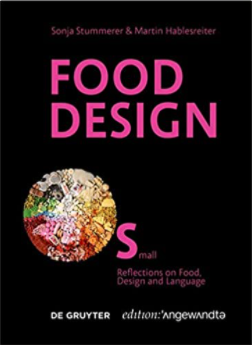Weekend reading (or thinking): Food Design
Sonja Stummerer & Martin Hablesreiter. Food Design Small: Reflections on Food, Design and Language. De Gruyter 2020.

Their other books are bigger: Food Design XL (2009) and Eat Design (2014).
These are unusual, to say the least, and great fun.
For one thing, the authors do not take themselves too seriously: They like to be known as honey and bunny, lower case.
For another, they think of food primarily as a design object. Of vegetables cut into small cubes, for example, they say:
Whether the design of frozen vegetables into small cubes is simple, functional, appropriate for the product and timeless, and of greater or lesser practical use, cannt be answered withoiut an adequate reference system (value system, ideology). From today’s perspective, the answer would probaly be negative even though there is undeniably a certain timelessness about the product.
They point out that specific shapes convey specific associations.
Food in the shape of a triangle is actually rather unusual: psychologically because it always has an acute angle pointing at the consumer; ergonomically (especially with small objects such as chocolates) because it fits poorly in the mouth; and technically because (industrially) triangles are not easy to produce, stack and package. One exception is the Toblerone….
And they are very much into semiotic theories, which, they say, can illuminate our lives and help solve environmental problems.
The photographs are in black and white but give the idea of how honey and bunny use food and dining as design objects (the photos are bigger, better, and more colorful in the XL version).
If you like this sort of thing—and I most definitely do—this is a quirky book that encourages thinking about food in entirely different ways.
Great fun indeed.
As to why it matters, let me quote from the introduction to the book by my NYU colleague Fabio Parasecoli:
What is important to me is nt so much elaboratig a univocal and final definition of food design, but rather understanding why we are even talking about food design, how and why it emerged, how it connects to the developments within design at large, and why it is emerging at this specific historical point in time. There may not be any firm answers yet, but it is quite likely that food design is a manifestation of the overall growing interest in food and the acknowledgment of its centrality to huma life.

